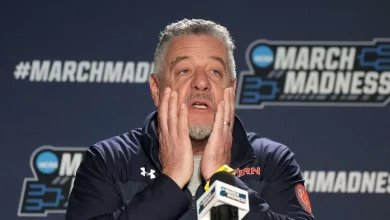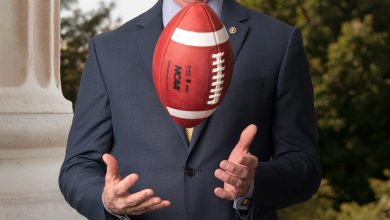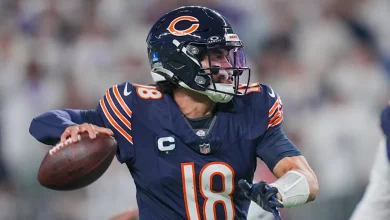Caleb Williams of the Chicago Bears is under pressure to perform well in his sophomore season.

The weight of expectation on Chicago Bears quarterback Caleb Williams heading into his sophomore NFL season in 2025 is arguably unprecedented for a second-year signal-caller. After a rookie campaign that, while statistically impressive in some aspects, also saw him endure a league-high 68 sacks and a 5-12 team record, the stage is set for a truly pivotal Year 2. The Bears have gone to extraordinary lengths to build a formidable support system around him, effectively eliminating many of the excuses that could have been made for a struggling first-year quarterback.
The Immense Pressure of a “Generational” Talent
Williams arrived in Chicago as the No. 1 overall pick in the 2024 NFL Draft, universally hailed as a “generational” talent. His Heisman Trophy-winning career at USC showcased a unique blend of elite arm talent, uncanny creativity, and the ability to make breathtaking plays off-script. The Bears’ decision to draft him signaled a complete philosophical reset for a franchise historically starved for consistent quarterback play. This isn’t merely about individual statistics; it’s about being the foundational piece that finally lifts a long-suffering franchise back to relevance and ultimately, into Super Bowl contention
Prominent NFL analysts, including ESPN’s Dan Orlovsky, have explicitly stated that Williams is under more pressure than any other quarterback in the entire NFL in 2025. This isn’t a knock on Williams’ ability, but rather a direct reflection of the significant resources and strategic maneuvers the Bears have deployed to ensure his success. The organization has pulled out all the stops, and now the onus is squarely on Williams to deliver.
A Transformed Supporting Cast: No More Excuses
The most compelling reason for the amplified pressure on Williams is the dramatic, wholesale transformation of his supporting cast. General Manager Ryan Poles and the Bears’ front office have executed an aggressive, “all-in” approach to surround their young quarterback with talent and stability:
-
Elite Coaching Prowess: The hiring of Ben Johnson as head coach and offensive coordinator is perhaps the most impactful strategic move. Johnson was arguably the most coveted head coaching candidate in the NFL, renowned for his innovative, creative, and quarterback-friendly offensive schemes that consistently generate explosive plays. His track record of developing Jared Goff in Detroit into an MVP candidate bodes exceptionally well for Williams, who possesses a far superior physical skill set than Goff. This coaching stability and clear offensive vision are paramount for a young quarterback’s development, as a constant carousel of play-callers and conflicting schemes can severely impede progress. Johnson’s presence provides a consistent, high-level framework for Williams to thrive within.
-
Radically Upgraded Offensive Line: One of the most glaring deficiencies during Williams’ rookie season was the offensive line, which surrendered a staggering, league-worst 68 sacks. The Bears have addressed this critical area with remarkable aggression and investment. Key additions like two-time All-Pro Joe Thuney and Pro Bowl guard Jonah Jackson on the interior, along with the highly-graded center Drew Dalman, have reshaped the unit. Pro Football Focus now ranks the Bears’ interior offensive line among the best in the league. With promising young tackles like Braxton Jones and Darnell Wright, the entire offensive line is projected to be in the top half of the NFL, if not higher. This dramatic improvement directly impacts Williams’ ability to remain clean in the pocket, allow plays to develop naturally, and avoid the “hero ball” tendencies that sometimes led to unnecessary sacks during his college career. The reduction in pressure will be a game-changer for his comfort and effectiveness.
-
Dynamic Playmakers at Every Level: Williams now boasts an embarrassment of riches in terms of pass-catching talent and a strong running game. DJ Moore remains a bona fide Pro Bowl-caliber No. 1 receiver, a reliable and explosive target. The addition of rookie Rome Odunze, widely considered a top-tier talent in his draft class, provides another high-upside target with exceptional contested-catch ability. The tight end room, featuring the established Cole Kmet and the promising addition of Colston Loveland, offers versatile and reliable options, with Loveland’s ability to line up in the slot creating matchup nightmares for opposing defenses. Furthermore, the signing of D’Andre Swift to lead an improved backfield ensures a potent running game that will both alleviate pressure on Williams and open up play-action opportunities. This wealth of talent means Williams will have an abundance of targets to distribute the ball to, allowing Johnson’s scheme to truly flourish.
The Sophomore Season Trajectory and Analytical Projections
Historically, the sophomore season often serves as a critical barometer for a quarterback’s long-term viability in the NFL. While some quarterbacks experience a “rookie wall” or simply plateau, many make significant leaps in their second year as they adapt to the speed of the NFL game, internalize complex schemes, and grow more comfortable with the immense demands of the position. For Williams, the expectation isn’t just incremental improvement; it’s a substantial jump in both production and efficiency.
In his rookie year, Williams completed 62.5% of his passes for 3,541 yards, 20 touchdowns, and just six interceptions. While these numbers are respectable for a rookie, the league-high 68 sacks and a negative EPA (Expected Points Added) that ranked 35th among qualified quarterbacks (ahead of only Will Levis) highlighted areas for significant refinement. PFF, despite some initial concerns, has surprisingly projected Williams to be the “most improved quarterback” in 2025. This projection heavily relies on his ability to quicken his internal clock, make quicker decisions, and reduce his tendency to hold onto the ball too long, which directly contributed to many of those sacks. The improvement in offensive line play should naturally facilitate this, but Williams’ personal growth in this area will be crucial.
Addressing Pre-Draft Narratives and Public Perception
Adding another layer of scrutiny is the lingering pre-draft narrative, recently brought back into the spotlight by excerpts from Seth Wickersham’s book, suggesting that Williams and his father explored avenues to avoid being drafted by the Bears. While the Bears’ organization and Williams’ current demeanor suggest this is a non-issue, the media attention surrounding it places an additional microscope on his commitment and future performance. Williams has largely maintained a stoic silence on the matter, while Head Coach Ben Johnson has publicly downplayed it, emphasizing Williams’ pride in being a Bear. However, some analysts contend that a public statement from Williams himself would have definitively diffused the situation. Regardless, the most effective way for Williams to silence any lingering doubts about his desire to be in Chicago is to perform at an elite level on the field.
A Favorable Schedule and Contractual Implications
The Bears’ 2025 schedule presents a relatively manageable start, particularly in the initial weeks of the season. This early stretch could provide Williams with an opportunity to build confidence, establish a strong rhythm within Johnson’s new system, and allow the revamped offensive unit to gel. While the back half of their schedule features some tougher matchups, the initial foundation building will be invaluable.
From a contractual standpoint, Williams is currently on a four-year, $39.48 million fully guaranteed rookie contract, which includes a $25.53 million signing bonus. As he progresses through this deal, his performance will be the sole determinant of his long-term value to the Bears and his eventual second contract. A strong sophomore season could put him on an accelerated path to a lucrative extension.
Caleb Williams enters his sophomore season under an immense spotlight, but it’s a pressure born from unparalleled opportunity and extraordinary organizational investment. The Chicago Bears have meticulously crafted an environment designed for his success, providing a highly regarded offensive coaching staff, a dramatically improved offensive line, and an influx of dynamic offensive weapons. There are now very few external factors left to point to if he were to struggle. The narrative has definitively shifted from “can he survive?” to “how great can he be?”
For Williams, this season is about more than just individual statistics; it’s about proving unequivocally that he is the franchise quarterback the Bears have yearned for for decades. It’s about translating his “generational” talent into consistent NFL production, leading his team to a winning record, and ultimately, fulfilling the immense promise that made him the unquestioned No. 1 overall pick. The scrutiny will be intense, the expectations sky-high, but for a player with Williams’ purported confidence and evident talent, this is precisely the kind of challenge he should embrace. The trajectory of the Chicago Bears franchise for the foreseeable future now rests squarely on the shoulders of Caleb Williams









